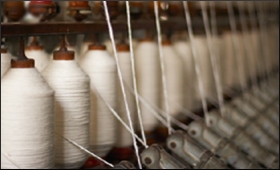|

|
Textile industry jittery as cotton crisis deepens
|
|

|
|
| Top Stories |
 |
|
|
|
SME Times News Bureau | 14 Sep, 2010
The unprecedented cotton crisis, triggered by the runaway prices and vaulted demand for exports, will fritter away the textile advantage of India, said the Indian textile industry, adding the government needs to take immediate measures to safeguard interests of the the domestic textile and clothing industry.
At a press conference held Monday in Delhi under joint auspices of the textile and clothing associations of India, the textile industry called upon the government to design policies on a durable basis for the survival of the entire textile and clothing industry and to lend a measure of support to its exports.
"We would request that the government policies may be designed to ensure that the benefits of Indian cotton are available to the domestic textile industry, rather than to industries of China, Pakistan and Bangladesh, which otherwise would be competing with us in the global textile and clothing markets on the strength of the Indian cotton," the textile industry leaders said in a joint letter.
The letter was addressed to the Prime Minister, Finance Minister, Commerce Minister, Textile Minister and high ranking officials.
Speaking at the press conference, Confederation of Indian Textile Industry (CITI) Chairman, Shishir Jaipuria pointed out that cotton prices are still high despite bumper crop of 295 lakh bales during cotton year 2009-10 (October âDecember).
".... at this price, textile mills cannot run viably and most mills are likely to incur losses, which will force them to default on repayment of huge loans they have taken under Technology Upgradation Fund Scheme (TUFS)," he added.
"The government announcement of cotton exports being removed from the restricted list resulted in an increase of around Rs.6000 a candy within a few weeks," said CITI Deputy Chairman, S.V. Arumugam said.
Commenting on the issue, FIEO President A Sakthivel added, "Export policy of cotton has been changed from restricted to free earlier this year and the stipulation of license for exports has also been withdrawn. Thus, the Department of Commerce cannot put any restrictions on cotton exports under the current policy."
Southern India Mills Association (SIMA) Chairman, J Thulasidharan pointed out while rains may delay the arrival of the new crop in the northern zone at least up to the middle of October 2010, there are reports that large quantities from the new cotton crop are being purchased by traders through forward cover, which will further reduce and delay the availability of cotton to the mills.
The textile industry leaders viewed that the government, in the above scenario, needs to lend a helping hand to the textile industry at the earliest.
They suggested a slew of measures that include restriction on registration of contracts for exports of cotton for the period January-September 2011 to 49.5 lakh bales, permission of registration of contracts only for exports to actual users, enforcement of an export duty of Rs.10000 per ton for cotton, and immediate withdrawal of export incentive of 1.5 percent being given on exports of raw cotton.
The textile industry said that registration of contracts should not be allowed for cotton exports during the period October-December 2010 so that the best cotton of the country that arrives in the market during this period will be available for the domestic textile industry.
In Foreign Trade Policy, cotton should immediately be brought back to restricted list subject to export licensing, and the government should review the exportable surplus in mid November 2010, as reportedly proposed by government, the industry added.
|
|
|
| |
|
|
|
|
|
|
|
marketing strategy of indian cotton industry
shobha | Mon Dec 6 09:33:52 2010
Please send me the marketing strategy of indian cotton industry (yesterday/ today / tommorrow)mail me on shobhajbs@sify.com

Think about our nation
P.Venkateswaran. | Fri Sep 24 09:07:30 2010
The govt should ban the cotton / yarn export until the domestic requirements will be fulfiled.

|
|
|
|
|
|
|
| |
| Customs Exchange Rates |
| Currency |
Import |
Export |
US Dollar
|
66.20
|
64.50 |
UK Pound
|
87.50
|
84.65 |
Euro
|
78.25
|
75.65 |
| Japanese
Yen |
58.85 |
56.85 |
| As on 13 Aug, 2022 |
|
|
| Daily Poll |
 |
 |
| PM Modi's recent US visit to redefine India-US bilateral relations |
|
|
|
|
|
| Commented Stories |
 |
|
|
|
|
|
| |
|